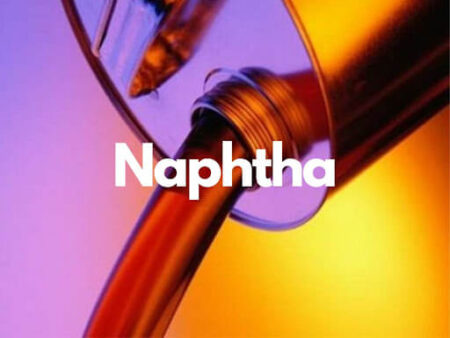Naphtha

Business Solutions
Naphtha is obtained in petroleum refineries as one of the intermediate products from the distillation of crude oil. It is a liquid intermediate between the light gases in the crude oil and the heavier liquid kerosene. Naphthas are volatile, flammable and have a specific gravity of about 0.7. The generic name ‘naphtha’ describes a range of different refinery intermediate products used in different applications. Naphtha is a deep amber to dark red liquid, a mixture of xylene and higher homologs; crude, dark straw-colored liquid; refined, water-white liquid
Petroleum naphtha is an intermediate hydrocarbon liquid stream derived from the refining of crude oil with CAS-no 64742-48-9. It is most usually desulfurized and then catalytically reformed, which rearranges or restructures the hydrocarbon molecules in the naphtha as well as breaking some of the molecules into smaller molecules to produce a high-octane component of gasoline (or petrol).
There are hundreds of different petroleum crude oil sources worldwide and each crude oil has its own unique composition or assay. There are also hundreds of petroleum refineries worldwide and each of them is designed to process either a specific crude oil or specific types of crude oils. Naphtha is a general term as each refinery produces its own naphthas with their own unique initial and final boiling points and other physical and compositional characteristics.
Naphthas may also be produced from other material such as coal tar, shale deposits, tar sands, and the destructive distillation of wood.
The first unit operation in a petroleum refinery is the crude oil distillation unit. The overhead liquid distillate from that unit is called virgin or straight-run naphtha and that distillate is the largest source of naphtha in most petroleum refineries. The naphtha is a mixture of many different hydrocarbon compounds. It has an initial boiling point(IBP) of about 35 °C and a final boiling point (FBP) of about 200 °C, and it contains paraffins, naphthenes (cyclic paraffins) and aromatic hydrocarbons ranging from those containing 4 carbon atoms to those containing about 10 or 11 carbon atoms.
The virgin naphtha is often further distilled into two streams:
- a virgin light naphtha with an IBP of about 30 °C and a FBP of about 145 °C containing most (but not all) of the hydrocarbons with six or fewer carbon atoms
- a virgin heavy naphtha containing most (but not all) of the hydrocarbons with more than six carbon atoms. The heavy naphtha has an IBP of about 140 °C and a FBP of about 205 °C.
The virgin heavy naphtha is usually processed in a catalytic reformer, because the light naphtha has molecules with six or fewer carbon atoms—which, when reformed, tend to crack into butane and lower molecular weight hydrocarbons that are not useful as high-octane gasoline blending components. Also, the molecules with six carbon atoms tend to form aromatics, which is undesirable because the environmental regulations of a number of countries limit the amount of aromatics (most particularly benzene) in gasoline
Some refinery naphthas also contain some olefinic hydrocarbons, such as naphthas derived from the fluid catalytic cracking, visbreakers and coking processes used in many refineries. Those olefin-containing naphthas are often referred to as cracked naphthas.
In some (but not all) petroleum refineries, the cracked naphthas are desulfurized and catalytically reformed (as are the virgin naphthas) to produce additional high-octane gasoline components.
Some petroleum refineries also produce small amounts of specialty naphthas for use as solvents, cleaning fluids, paint and varnish diluents, asphalt diluents, rubber industry solvents, dry cleaning, cigarette lighters, recycling products, and portable camping stove and lantern fuels. Those specialty naphthas are subjected to various purification processes.
Sometimes the specialty naphthas are called petroleum ether, petroleum spirits, mineral spirits, paraffin, benzine, hexane, ligroin, white oil or white gas, painters naphtha, refined solvent naphtha and Varnish makers’ & painters’ naphtha (VM&P). The best way to determine the boiling range and other compositional characteristics of any of the specialty naphthas is to read the Safety Data Sheet (SDS) for the specific naphtha of interest.
On a much larger scale, petroleum naphtha is also used in the petrochemicals industry as feedstock to steam reformers and steam crackers for the production of hydrogen (which may be and is converted into ammonia for fertilizers), ethylene, and other olefins. Natural gas is also used as feedstock to steam reformers and steam crackers.
We're Here To Help!
Office
South Al Mabilah
Al Seeb / Muscat, Oman
P.O.BOX 5280
Call Us
+96877228026
+96877548710
+96891322782

